Showing food fact sheet for strawberry
Scrumptious Strawberries
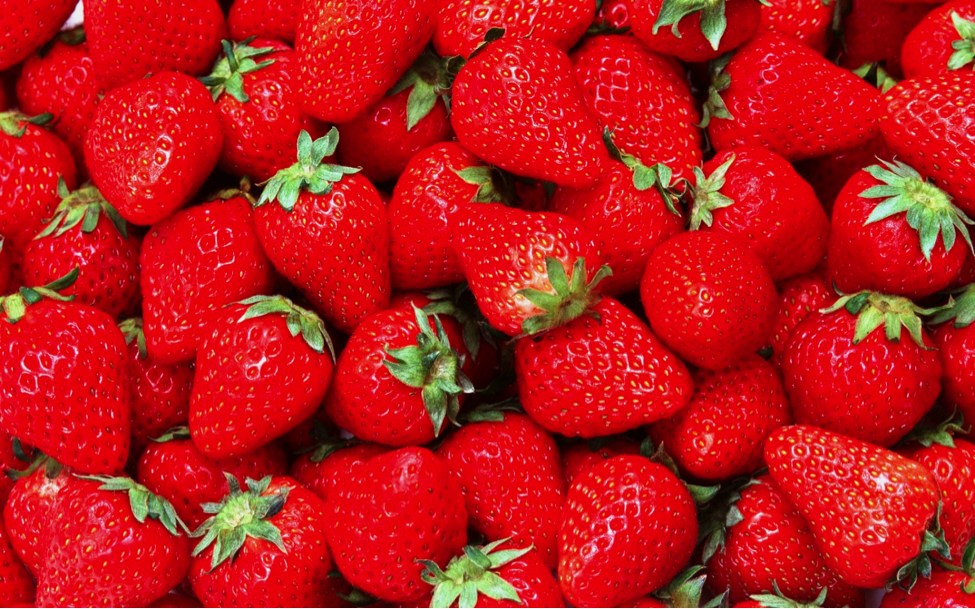 |
Juicy, sweet, and ruby red, strawberries are a delight for the eyes and tastebuds! But did you know that there's more to these delightful berries than just aesthetics? This common and popular fruit, scientifically known as Fragaria ananassa, is a phyto-nutrient powerhouse, containing a huge variety of phenolic compounds. These compounds include fisetin, ellagitannins, and flavanols and are associated with anti-inflammatory, antimicrobial effects, improving heart health, and anti-cancer properties! Another interesting fact about these beautiful berries is that they're not actually berries! That's right, strawberries are considered to be accessory fruits, meaning that some part of the "fruit" is made up of tissue that isn't derived from the plant's ovary. In the case of strawberries, the red fleshy part is the accessory to the real fruit, a type of achene: seen on strawberries as the dried-up seeds dotting the surface. The origins of strawberries are in the wild woodlands of Europe, but of course, now they're a worldwide phenomenon. Great in pies, jams, spreads, with ice cream, in a fruit salad, or just by themselves, strawberries are a treat that's too tasty to be true!
Vitamins and Minerals
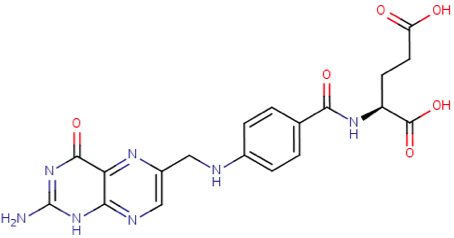 |
| Figure 2. Structural diagram of folate |
Strawberries are a great source of vitamin C, folate and manganese, three nutrients that are essential for our health! Vitamin C is crucial in maintaining collagen - a protein found in skin, bones, tendons, ligaments and many other parts of your body. It does this because it's a cofactor in various enzymes that are needed for collagen formation: including prolyl-3-hydroxylase, prolyl-4-hydroxylase, and lysyl hydroxylase [Prockop]. Without vitamin C, you would develop a disease called "scurvy", which is characterized by bleeding gums, spotty skin, jaundice and wounds that don't heal. Vitamin C is also a critical cofactor that plays a key role in fat and hormone metabolisms [Higdon]. Vitamin C is required for enzymes that synthesize carnitine, which is needed for ATP production in the mitochondria [Rebouche, Paddayatty]. Folate (a.k.a. vitamin B9) is an important nutrient for pregnant women - it prevents neural tube defects (such as spina bifida or anencephaly). New red blood cells require folate for their development, and folate breaks down a harmful amino acid known as homocysteine that increases the risk of cardiovascular disease [Lucock]. As for manganese, it can be found in the active site of many enzymes that are used in key metabolic pathways. Some of the many enzymes include arginase, glutamine synthetase, xylosyltransferases, phosphoenolpyruvate decarboxylase, and manganese superoxide dismutase (MnSOD), and they play a major role in protein, carbohydrate, and cholesterol metabolism [Roth]. Manganese is important for maintaining bone health and metabolic processes, as many of these enzymes are involved in these processes [National Research Council].
Bottom Line: Strawberries are a superb source of several essential nutrients!
Fisetin for Brain Function
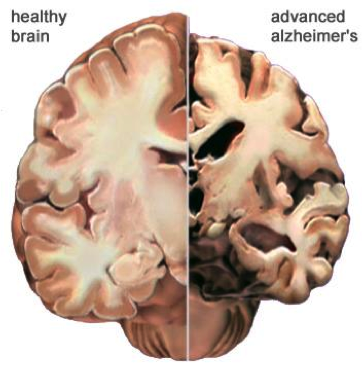 |
| Figure 3. A graphic comparing a healthy brain to an Alzheimer's affected brain |
| http://www.alz.org/braintour/ images/alzheimer_brain.jpg |
A very recent study has found that a compound contained in strawberries is helpful in preventing the onset of Alzheimer's disease (AD), as well as improving neurological function [Currais]. This compound is a flavonol (a type of flavonoid with an attached phenolic hydroxide) called fisetin, and is thought to counteract AD by increasing levels of a cyclin-dependent kinase 5 (Cdk5) activator, called p35. But before we can understand how it goes against the disease, let's break down what this mechanism really does! In general, cyclin-dependent kinases are important in cell-signalling and regulating transitions in the cell cycle, through the process of phosphorylation, which is where phosphates are added to or subtracted from proteins at different sites, which will affect their roles and functions [Nigg, Chang, Cohen]. This process is important in the main role of Cdk5, which is a stimulator of neural tissue growth, especially neurofilaments (which make up neurons), activated by its subunit protein, p35 [Patrick 1998, Tsai]. This seems all fine and dandy, but the cause of catastrophe comes in the form of a cleavage product of the p35 protein, called p25. The production of p25 interferes with Cdk5 function, deregulating it, leading to Alzheimer's disease [Patrick 1999, Cruz 2004]. This is because p25 induces apoptosis (programmed cell death, leads to damaged neurons), and tau hyperphosphorylation (extra folding of neurofilaments, leads to neurofibrillary tangles, NFT's), both of which mean that Alzheimer's disease is progressing [Wang, Cruz 2003]. It has been thought that the only way to deal with Alzheimer's is by suppressing Cdk5, but this had negative side effects [Lopez-Tobon]. But all hope is not lost! Fisetin from strawberries can save the day by decreasing inflammation and increasing the amount of p35! Both of these mean that the progression of AD is slowed. Fisetin is able to decrease inflammation in two ways: 1) decreasing the synthesis of eicosanoids (pro-inflammatory signalling molecules), and 2) increasing prostaglandin synthesis (anti-inflammatory regulating lipids, with the products J2 (PGJ2) and 15-deoxy-PGD2 (15d-PGD2) [Currais]. Also, fisetin increases the amount of p35 by increasing the phosphorylation of extracellular-signal-regulated kinases (ERK), another important neural regulator [Desbarats, Perry]. This allows for normal neural functioning to occur, and has the good side effect of reducing cleavage of p35, the process that creates the bad p25 protein!
Bottom Line: Keep your neurons in running order by eating fisetin-rich strawberries!
Strawberries and Heart Health
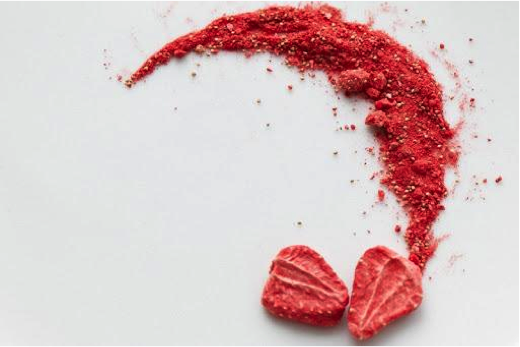 |
| Figure 4. Freeze dried strawberries |
The reds and blues of fruit can be attributed to a group of plant pigments called anthocyanins [Wallace]. Anthocyanins constitute the largest subgroup of phenolic compounds in strawberries [Rothwell]. This chemical group has been found to have many biological benefits, from anti inflammatory to anti-carcinogenic activity [Mazza]. Perhaps the most notable effect of anthocyanins is their ability to reduce the risk of cardiovascular disease (CVD) [Wallace]. The reduction of CVD risk from fruit consumption has been linked to the presence of anthocyanins and flavonoids (a group that includes anthocyanins) in fruit [de Pascual-Teresa]. Berries, rich in flavonoids, are a berry heart healthy choice [Erlund/Hannum]. Higher consumption of flavonoids have been linked to reduced death due to CVD in older women [Yochum/Mink]. Similarly, increased intakes of anthocyanins are associated with fewer heart attacks in younger women [Cassidy]. Similar to these findings comes a study indicating lower flavonoid intake leads to higher CVD risk [Knekt]. Increased consumption of strawberries led to reduced CVD risk factors (lipid profile, anti hemolysis and improved platelet function) in a short-term study [Alvarez-Suarez]. Astronauts rejoice: a small study showed consumption of freeze-dried strawberry powder reduced levels of LDL cholesterol and decreased lipid peroxidation in women with metabolic syndrome [Basu]. Whole strawberries also reduce LDL cholesterol and lipid peroxidation in hyperlipidemic subjects [Jenkins]. These reductions are important steps for reducing the risk of CVD. The effects of strawberry consumption on the cardiovascular system have been identified as inhibiting inflammation (through the downregulation of NF-KB activity) and platelet aggregation, improving the plasma lipid profile and endothelial function [Giampieri/Basu].
Bottom Line: Strawberries are among the best sources for phenolic heart healthy compounds!
Antimicrobial Properties of Strawberries
 |
| Figure 5. Coloured scanning electron micrograph of Campylobacter jejuni |
| (http://www.visualphotos.com/photo/1x6040257/ campylobacter_jejuni_bacterium_b2201277.jpg) |
Get rid of those mean microorganisms by eating strawberries! In strawberries, there are a few important phenolic compounds, like ellagitannins, ellagic acid, and terpenoids. These have been found to have an antimicrobial effect against Candida albicans (a common cause for yeast infections) and Campylobacter jejuni (the most common cause of gastroenteritis) [Kotzekiou, Nohynek]. Also, one study found that strawberry extract can immobilize and kill Staphylococcus aureus, a common culprit of wound and urinary tract infections: killing part of the organisms, and leaving some alive but unable to attach to surfaces. This means that although the organism is still somewhat alive, it cannot attach to infect you [Nohynek].
Because of these findings, new research is trying to find a way to prevent you from coming into contact with foodborne illness using strawberry extract [Kotzekidou]! The need for an organic form of preservative to stop microorganisms (without compromising health or flavour) might be found in strawberry extract, which can impair microorganisms even at very low concentrations. In Kotzekiou's research, common foodborne pathogens E. coli O157:H7, Salmonella enteritidis, Staphylococcus aureus, Listeria monocytogenes, and Bacillus cereus were inhibited by strawberry extract in vitro. It is thought that the strawberry extract can disrupt the phospholipid bilayer that makes up the cell membrane of the bacteria, which means the cell membrane permeability will increase, making the bacteria lose important cellular constituents. To add more insult to injury, strawberry extract damages enzymes the bacteria uses to create energy, a stable cell structure, and its genetic material. Not one compound is responsible for the antimicrobial activity of strawberries but it is thought to be the phenolic compounds and terpenoids mentioned earlier.
Bottom Line: Strawberries are full of phenolics that help fight the war on pathogens!
Anticancer
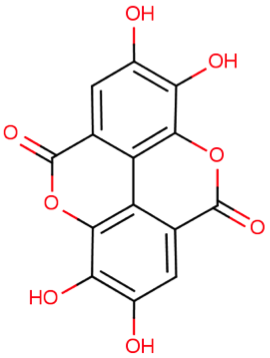 |
| Figure 6. Structural diagram of ellagic acid. |
Strawberries are a delicious source of anticancer phenols. These phenols are effective against several types of cancers [Seeram 2008]. Strawberry extract containing several types of phenols (anthocyanins, ellagitannins, flavanols, flavonols, gallotannins, phenolic acids and proanthocyanidins) inhibited growth of breast, colon, oral and prostate cancers (in vitro) [Seeram 2006]. Furthermore, the strawberry extract was an effective colon cancer killer (in vitro), inducing apoptosis in COX-2 expressing cells (an inflammatory and pain causing enzyme) [Seeram 2006]. In another study, strawberry extract was effective in preventing the proliferation of lung cancer cells (in vitro), through the down-regulation of NF-KB (a kinase) and activator protein 1 [Wang]. Compared to other berries (arctic bramble, lingonberry and cloudberry), strawberries came out on top as the most effective against cervical and colon cancer cell lines (in vitro); this was attributed to ellagitannins in the berries [McDougall]. When it comes to cancer stopping, it appears organic strawberries are somewhat more effective than their conventional counterpart, at least against colon and breast cancers (in vitro) [Olsson]. This may be due to higher concentrations of phenols in organic strawberries [Olsson]. In another study, strawberry extract inhibited the growth of colon, oral and prostate cancers [Zhang]. The phenols in the extract were identified as anthocyanins (cyanidin-3-glucoside, pelargonidin, pelargonidin-3-glucoside and pelargonidin-3-rutinoside), flavonols (kaempferol, quercetin and kaempferol-3-(6'-coumaroyl)glucoside), a hydroxybenzoic acid (ellagic acid) and a hydroxycinnamic acid (an ester of p-coumaric acid) [Rothwell/Zhang]. The anticancer action of these chemicals is due to several mechanisms. One such mechanism is inducing phase II metabolizing enzymes (glutathione S-transferase, quinine oxidoreductase and UDP-glucuronyl transferase), used in drug metabolism [Dai]. Another cancer stopping mechanism is inducing cell cycle arrest through the down-regulation of cyclins (involved in cell cycle regulation), thus preventing rapid cell division associated with cancer [Dai]. These phenolics can also stop cancer through apoptosis, using many different pathways - the most common being caspase-3 mediated [Dai]. Other methods involve the blocking of kinase proteins (extracellular signal-regulated kinases, c-Jun N-terminal kinases and P38 mitogen-activated protein kinases), inhibiting the activation of transcription factors (NF-KB and activator protein 1), the suppression of protein kinase C, or the suppression of growth factor-mediated pathways [Dai]. Another way these chemicals are stopping cancer is through the inhibition of inflammatory transcription factors (NF-KB) [Dai]. These mechanisms are likely synergistic, involving other phytochemicals in the berry, such as carotenoids - a group of several hundred pigments present in many life forms [Liu/Stoner]. On their own, phenols cannot account for the antiproliferative effects of strawberries on cancer - reason states that other chemicals in strawberries account for the summative anticarcinogenic effects of the berries (even if they're not berries) [Liu].
Bottom Line: Strawberries are superb at stopping cancer!
http://moldb.wishartlab.com/molecules/HMDB02899/image.png
References
Vitamins and Minerals
- Prockop JD. Collagens: molecular biology, diseases, and potentials for therapy. Annu Rev Biochem. 1995;64(1):403-434.
- Jane Higdon. Vitamin C. http://lpi.oregonstate.edu/infocenter/vitamins/vitaminC/ (accessed 10 July 2014).
- Rebouche CJ. Ascorbic acid and carnitine biosynthesis. Am J Clin Nutr. 1991;54(6):1147S-1152S.
- Padayatty SJ, Katz A, Wang Y, Eck P, Kwon O, Lee JH, et al. Vitamin C as an antioxidant: evaluation of its role in disease prevention. J Am Coll Nutr. 2003;2291):18-35.
- Lucock M. Folic acid: nutritional biochemistry, molecular biology, and role in disease processes. Mol Genet Metab. 2000;71(1-2):121-38.
- Roth J, Ponzoni S, Aschner M. Manganese homeostasis and transport. Met Ions Life Sci. 2013;12:169-201
- National Research Council. Dietary Reference Intakes for Vitamin A, Vitamin K, Arsenic, Boron, Chromium, Copper, Iodine, Iron, Manganese, Molybdenum, Nickel, Silicon, Vanadium, and Zinc. Washington, DC: The National Academies Press, 2001.
Fisetin
- Currais A, Prior M, Dargusch R, Armando A, Ehren J, Schubert D, et al. Modulation of p25 and inflammatory pathways by fisetin maintains cognitive function in Alzheimer's disease transgenic mice. Aging Cell. 2014;13(2):379-390.
- Nigg EA. Cyclin-dependent protein kinases: key regulators of the eukaryotic cell cycle. Bioessays. 1995;17(6):471-480.
- Chang EJ, Begum R, Chait BT, Gaasterland T. Prediction of Cyclin-Dependent Kinase Phosphorylation Substrates. PLoS ONE. 2007;2(8):e656.
- Cohen P. The regulation of protein function by multisite phosphorylation-a 25 year update. Trends Biochem Sci. 2000;25(12):596-601.
- Patrick GN, Zhou P, Kwon UT, Howley PM, Tsai LH. p35, the neuronal-specific activator of cyclin-dependent kinase 5 (Cdk5) is degraded by the ubiquitin-proteasome pathway. J Biol Chem. 1998;273(37):24057-24064.
- Tsai Lh, Delalle I, Caviness VS, Chae T. p35 is a neural-specific regulatory subunit of cyclin-dependent kinase 5. Nature 1994;371(6496):419-423.
- Patrick GN, Zukerberg L, Nikolic M, de La Monte S, Disskes P, Tsai LH. Conversion of p35 to p25 deregulates Cdk5 activity and promotes neurodegeneration. Nature. 1999;402(6762):615-622.
- Cruz JC, Tsai LH. Cdk5 deregulation in the pathogenesis of Alzheimer's disease. Trends Mol Med. 2004;10(9):452-458.
- Wang JZ, Xia YY, Grundke-Iqbal I. Abnormal hyperphosphorylation of tau: sites, regulation, and molecular mechanism of neurofibrillary degeneration. J Alzheimers Dis. 2013;33:S123-S139.
- Cruz JC, Tseng HC, Goldman JA, Shih H, Tsai LH. Aberrant Cdk5 activation by p25 triggers pathological events leading to neurodegeneration and neurofibrillary tangles. Neuron. 2003;40(3):471-483.
- Lopez-Tobon A, Castro-Álvarez JF, Piedrahita D, Boudreau RL, Gallego-Gómez JC, Cardona-Gómez GP. Silencing of CDK5 as potential therapy for Alzheimer's disease. Rev Neurosci. 2011;22(2): 143-152.
- Desbarats J, Birge RB, Mimouni-Rongy M, Weinstein DE, Palerme JS, Newell MK. Fas engagement induces neurite growth through ERK activation and p35 upregulation. Nat Cell Biol. 2003;5(2):118-125.
- Perry G, Roder H, Nunomura A, Takeda A, Friedlich AL, Zhu X, Smith MA. Activation of neuronal extracellular receptor kinase (ERK) in Alzheimer disease links oxidative stress to abnormal phosphorylation. Neuroreport. 1999;10(11):2411-2415.
Strawberries and Heart Health
- Wallace TC. Anthocyanins in cardiovascular disease. Adv Nutr. 2011;2(1):1-7.
- Rothwell JA, Pérez-Jiménez J, Neveu V, Medina-Ramon A, M'Hiri N, Garcia Lobato P, et al. (2013) Phenol-Explorer 3.0: a major update of the Phenol-Explorer database to incorporate data on the effects of food processing on polyphenol content.
- Mazza GJ. Anthocyanins and heart health. Ann Ist Super Sanita. 2007;43(4):369-74.
- de Pascual-Teresa S, Moreno DA, Garcia-Viguera C. Flavanols and anthocyanins in cardiovascular health: a review of current evidence. Int J Mol Sci. 2010;11(4):1679-703.
- Erlund I, Koli R, Alfthan G, Marniemi J, Puukka P, Mustonen P, et al. Favorable effects of berry consumption on platelet function, blood pressure, and HDL cholesterol. Am J Clin Nutr. 2008;87(2):323-31.
- Hannum SM. Potential impact of strawberries on human health: a review of the science. Crit Rev Food Sci Nutr. 2004;44(1):1-17.
- Yochum L, Kushi LH, Meyer K, Folsom AR. Dietary flavonoid intake and risk of cardiovascular disease in postmenopausal women. Am J Epidemiol. 1999;149(10):943-9.
- Mink PJ, Scrafford CG, Barraj LM, Harnack L, Hong CP, Nettleton JA, et al. Flavonoid intake and cardiovascular disease mortality: a prospective study in postmenopausal women. Am J Clin Nutr. 2007;85(3):895-909.
- Cassidy A, Mukamal KJ, Liu L, Franz M, Eliassen AH, Rimm EB. High anthocyanin intake is associated with a reduced risk of myocardial infarction in young and middle-aged women. Circulation. 2013;127(2):188-96.
- Knekt P, Jarvinen R, Reunanen A, Maatela J. Flavonoid intake and coronary mortality in Finland: a cohort study. BMJ. 1996;312(7029):478-81.
- Alvarez-Suarez JM, Giampieri F, Tulipani S, Casoli T, Di Stefano G, González-Paramás AM, et al. One-month strawberry-rich anthocyanin supplementation ameliorates cardiovascular risk, oxidative stress markers and platelet activation in humans. J Nutr Biochem. 2014;25(3):289-94.
- Basu A, Wilkinson M, Penugonda K, Simmons B, Betts NM, Lyons TJ. Freeze-dried strawberry powder improves lipid profile and lipid peroxidation in women with metabolic syndrome: baseline and post intervention effects. Nutr J. 2009;8:43.
- Jenkins DJ, Nguyen TH, Kendall CW, Faulkner DA, Bashyam B, Kim IJ, et al. The effect of strawberries in a cholesterol-lowering dietary portfolio. Metabolism. 2008;57(12):1636-44.
- Giampieri F, Tulipani S, Alvarez-Suarez JM, Quiles JL, Mezzetti B, Battino M. The strawberry: composition, nutritional quality, and impact on human health. Nutrition. 2012;28(1):9-19.
- Basu A, Rhone M, Lyons TJ. Berries: emerging impact on cardiovascular health. Nutr Rev. 2010;68(3):168-77.
- Sesso HD, Gaziano JM, Jenkins DJ, Buring JE. Strawberry intake, lipids, C-reactive protein, and the risk of cardiovascular disease in women. J Am Coll Nutr. 2007;26(4):303-10.
Antibacterial Strawberries
- Nohynek LJ, Alakomi HL, Kahkonen MP, Heinonen M, Helander IM, Oksman-Caldentey KM, et al. Berry phenolics: antimicrobial properties and mechanisms of action against severe human pathogens. Nutr Cancer. 2006;54(1):18-32.
- Kotzekidou P, Giannakidis P, Boulamatsis A. Antimicrobial activity of some plant extracts and essential oils against foodborne pathogens in vitro and on the fate of inoculated pathogens in chocolate. LWT-Food Sci Technol. 2008;41(1):119-127.
Anticancer
- Seeram NP. Berry fruits for cancer prevention: current status and future prospects. J Agric Food Chem. 2008 Feb 13;56(3):630-5.
- Seeram NP, Adams LS, Zhang Y, Lee R, Sand D, Scheuller HS, et al. Blackberry, black raspberry, blueberry, cranberry, red raspberry, and strawberry extracts inhibit growth and stimulate apoptosis of human cancer cells in vitro. J Agric Food Chem. 2006;54(25):9329-39.
- Wang SY, Feng R, Lu Y, Bowman L, Ding M. Inhibitory effect on activator protein-1, nuclear factor-kappaB, and cell transformation by extracts of strawberries (Fragaria x ananassa Duch.). J Agric Food Chem. 2005;53(10):4187-93.
- McDougall GJ, Ross HA, Ikeji M, Stewart D. Berry extracts exert different antiproliferative effects against cervical and colon cancer cells grown in vitro. J Agric Food Chem. 2008;56(9):3016-23.
- Olsson ME, Andersson CS, Oredsson S, Berglund RH, Gustavsson KE. Antioxidant levels and inhibition of cancer cell proliferation in vitro by extracts from organically and conventionally cultivated strawberries. J Agric Food Chem. 2006;54(4):1248-55.
- Zhang Y, Seeram NP, Lee R, Feng L, Heber D. Isolation and identification of strawberry phenolics with antioxidant and human cancer cell antiproliferative properties. J Agric Food Chem. 2008 Feb 13;56(3):670-5.
- Rothwell - cited in strawberries and heart health section
- Dai J, Mumper RJ. Plant phenolics: extraction, analysis and their antioxidant and anticancer properties. Molecules. 2010;15(10):7313-52.
- Liu RH. Potential synergy of phytochemicals in cancer prevention: mechanism of action. J Nutr. 2004 ;134(12 Suppl):3479S-3485S.
- Stoner GD, Wang LS, Casto BC. Laboratory and clinical studies of cancer chemoprevention by antioxidants in berries. Carcinogenesis. 2008;29(9):1665-74.